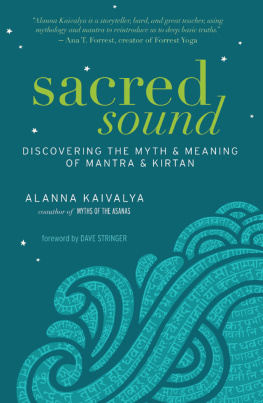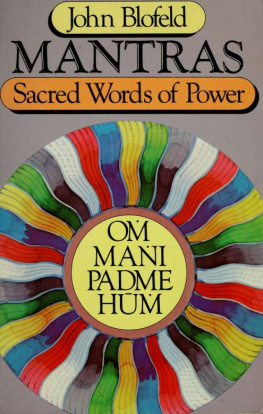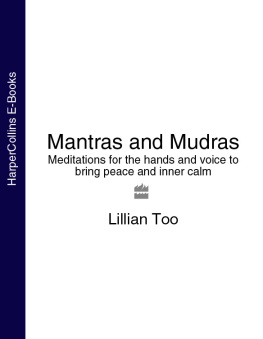Cover 2019 Sterling Publishing Co., Inc.
All rights reserved. No part of this publication may be reproduced, stored in a retrieval system, or transmitted in any form or by any means (including electronic, mechanical, photocopying, recording, or otherwise) without prior written permission from the publisher.
For information about custom editions, special sales, and premium and corporate purchases, please contact Sterling Special Sales at 800-805-5489 or .
INTRODUCTION
What are mantras? For thousands of years, the sacred sounds of mantras have been used to unlock the vast potential of the human heart and mind. These powerful tools can be found in cultures around the globe, offering accessible methods for healing, discovery, and well-being. I first came across mantras in my early twenties while I was living in the wilds of New York Citys East Village, working as a full-time musician and recording engineer. My introduction to mantras came after a deeply tumultuous time in my life, marked by the deaths of several immediate family members and the attacks of September 11. For many years I was shattered by the events of this time, trying to piece together a sense of wholeness and understanding. I experimented with many modalities of healing and transformation, seeking a new orientation to life that I am still discovering to this day.
My introduction to mantras came during this period and evoked a deep resonance in me. I would have never thought doing something as simple or weird as reciting words in another language could have such a profound effect on my lifebut they have. I have always felt at home in mantras. They have soothed me when nothing else would. They enabled me to walk through life more genuinely connected to myself and others. Over the past decade, they have become a cornerstone for me, a lifeline to the deepest parts of myself, and a means to learn how to live authentically from those places.
It has taken me many years to translate and understand the essence of this practice from its roots in Hindu philosophy, and skillfully apply it to my own life. This book is a synthesis of that exploration, and I hope it will jump-start your own journey into sacred sounds.
The book begins with the history of mantras from different traditions around the world and a look at my own lineage of Bhakti Yoga. Well investigate the many benefits of mantra practice on the brain and the body through recent scientific studies, substantiating what monks and yogis have contended for centuries. Next, well examine the core framework of practice methodology, which includes speaking, singing, and writing practice. Then well dive into the mantras themselves, introducing thirteen Sanskrit mantras from the Hindu tradition. Each mantra breakdown includes:
 Pronunciation Guide
Pronunciation Guide
 Benefits
Benefits
 Associated Deity
Associated Deity
 Literal Meaning
Literal Meaning
 Mythology and Folklore
Mythology and Folklore
 Practical Application
Practical Application
 Recommended Practices
Recommended Practices
There is also a supplemental practice companion that accompanies this book, with audio and visual resources to support your home practice. Lastly, youll learn creative ways to apply mantra practice on a daily basis with specific techniques for working with anxiety, negative emotions, challenging situations, health and healing, bringing intention to your routine, and more.
A Little Bit of Mantras is an in-depth introduction to the origins of sacred sounds for anyone interested in putting them into regular practice. The methods spelled out in this book have changed my life, giving me a comprehensive skill set to live with ease, humor, and joy, no matter what comes my way. So, whether you are brand-new to mantras or looking to expand your existing practice, get ready to go on a journey exploring the rich and expansive world of sacred soundsand the vast power they have to unlock our deepest potential.


Mantras are sacred sounds or sacred syllables. When repeated with dedication and focus, mantras serve as a means to steady the mind and open the heart. The word mantra originates from the Sanskrit language and was adopted into the English language in the late eighteenth century. The word can be broken into two roots, man and tra. Man is associated with the root for the word manas, which means mind. Tra is defined as crossing over. Combined, the literal translation of the word mantra is crossing over the mind. But what exactly does it mean to cross over the mind? What lies on the other side? And why would anyone want to go there? This whole concept is quite foreign to Western culture, except when we desperately want to get rid of a migraine! However, in the traditions of the East, seekers have been exploring practices to learn how to work with the mind for thousands of years, in search of greater happiness and well-being. These traditions believe that crossing over the mind allows us to gain access to the fullness of our being. Beyond our anxiety, distraction, and fearfulness lies a vast potential for greater connection, creativity, and curiosity. This is what awaits us in the world of mantras: an immense toolkit that enables us to inhabit our lives.
Since being adopted into the English language, the word mantra has taken on a broader meaning from its roots in Hindu culture. The Oxford English Dictionary primarily defines











 Pronunciation Guide
Pronunciation Guide
